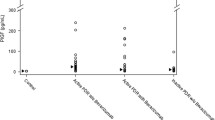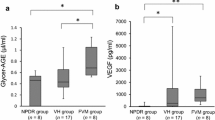Summary
Vascular endothelial growth factor (VEGF) plays a major role in the development of neovascularization in proliferative diabetic retinopathy (PDR). The source of intravitreous VEGF is presumably ischaemic retina, but increased levels derived from serum cannot be excluded. The aim of the study is to determine the intravitreous concentrations of VEGF in diabetic patients with PDR and to investigate whether serum VEGF could contribute to the intravitreous concentration. For this purpose, we studied 20 diabetic patients (5 IDDM and 15 NIDDM) with PDR in whom a vitrectomy was performed (group A). Non-diabetic patients (n = 13) with other conditions requiring vitrectomy served as a control group (group B). In both groups, VEGF was determined in serum and undiluted vitreous samples obtained simultaneously. Furthermore, serum VEGF was determined in 69 healthy control subjects (group C) and 39 diabetic patients without microvascular complications (group D). Vitreous and serum VEGF was determined by ELISA (R & D Systems, Abingdon, UK); intra-assay CV 3.8 %, interassay CV 5.1 %. Intravitreous concentrations of VEGF were strikingly higher in group A (median 1.75 ng/ml, range 0.33–6.66) in comparison with group B (median 0.009 ng/ml, range 0.009–0.038); p < 0.0001. This difference remained significant after adjusting for intravitreous protein concentration (p < 0.05). Differences in serum VEGF among the groups included in the study were not found. We conclude that the high vitreous levels of VEGF observed in diabetic patients with PDR cannot be attributed to serum diffusion across the blood-retinal barrier. Therefore, intraocular synthesis is the main contributing factor for the high vitreous VEGF concentrations observed in PDR. [Diabetologia (1997) 40: 1107–1109]
Article PDF
Similar content being viewed by others
Avoid common mistakes on your manuscript.
Author information
Authors and Affiliations
Additional information
Received: 27 May 1997
Rights and permissions
About this article
Cite this article
Burgos, R., Simó, R., Audí, L. et al. Vitreous levels of vascular endothelial growth factor are not influenced by its serum concentrations in diabetic retinopathy. Diabetologia 40, 1107–1109 (1997). https://doi.org/10.1007/s001250050794
Issue Date:
DOI: https://doi.org/10.1007/s001250050794




